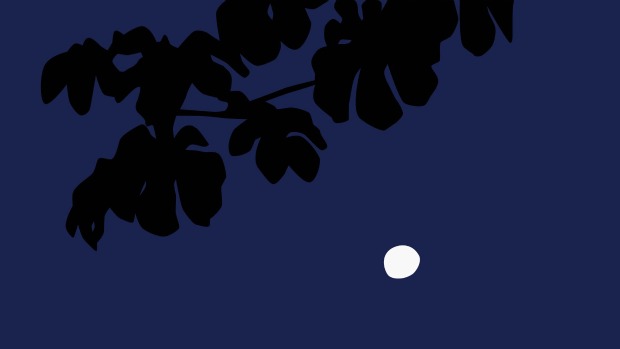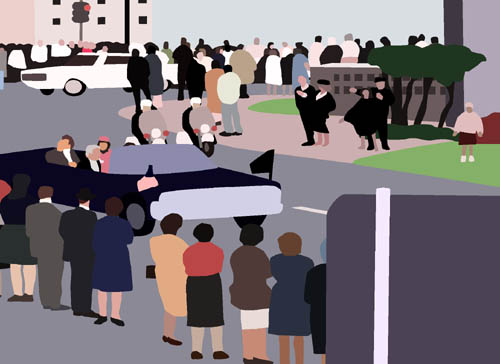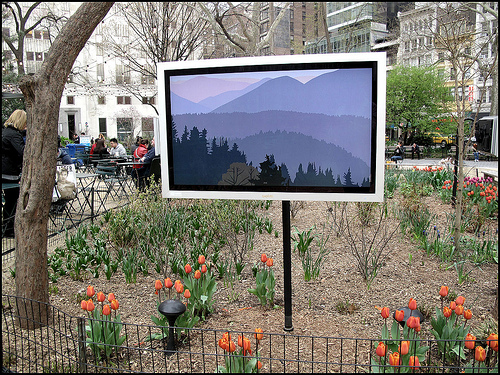
Kota Ezawa, "City of Nature" (2011). Video still. Courtesy the artist and Madison Square Park Conservancy
Christopher Nolan’s film Inception (2010) opens with a slow-motion shot of waves washing upon a sandy beach. The camera then pans to the protagonist Dom Cobb, played by Leonardo DiCaprio, lying face down in the sand, his body limp as the waves surge and retreat around him. This beach, we soon learn, is in fact an artificial construction. Cobb, we come to find out, has purposely entered this dream space in order to retrieve a friend, Saito, who has forgotten that he is lost in his dream—a fantasy space that seems so seductively real that in it a person might lose their sense of reality and become stuck. As we come to find out in the course of Nolan’s mind-bending film, rescue from this dream state hinges on somehow being able to establish that what is perceived to be reality is in fact little more than a figment of the subconscious. The question Inception poses but never fully resolves is whether these attempts to return to the real world are ever actually achieved and, more importantly, if in the end it even really matters.
I offer these brief remarks on Inception as a way to introduce Kota Ezawa’s video City of Nature (2011)—a video installation in which the artist has spliced together shots from over twenty different films—for two reasons; first, because the blurring of the distinction between the real and the imaginary is in many ways the subject of Ezawa’s latest work, and second because there is in City of Nature a shot of waves washing upon the shore that seems to have been appropriated from Inception’s opening sequence. And befitting the question posed by Inception, City of Nature asks the viewer not whether they can identify all of the different films from which Ezawa has appropriated his imagery but, more importantly, if in the end identifying the exact sources really even matters.

Kota Ezawa, "City of Nature" (2011). Video still. Courtesy the artist and Madison Square Park Conservancy.
City of Nature is a video commissioned by Madison Square Arts and currently on view in Madison Square Park in Manhattan, comprised of imagery appropriated by Ezawa from such feature-length films as Twin Peaks, Late Spring, Deliverance, Fitzcarraldo, Brokeback Mountain, Lord of the Flies and Jaws. As some of these film titles might suggest, each of the seventy scenes that make up City of Nature’s six-minute video is taken from a movie in which nature plays a significant role in the overall narrative. Employing freehand and vector-based, digitally assisted techniques, Ezawa animates these scenes of nature frame by frame, reducing the culled source material to graphically simplified, stylized forms that gives the original film footage a cartoon-like appearance. The resulting video montage of vividly colored, animated sequences plays in a continuous loop on four flat-screen monitors placed outside in the south end of the park. As each brief snippet of film (some merely a few seconds in duration) gives way to the next at a brisk pace, the images flashing across the monitors seem quite familiar—a shot of the full moon rising over trees, a majestic mountaintop, an idyllic waterfall, and of course waves washing upon a shoreline. By stripping these nature scenes of all narrative and reducing the imagery to flattened, two-dimensional forms, Ezawa focuses the viewer’s attention away from the specific source material and onto these tropes and motifs—clichés really—that repeatedly structure the visual representation of nature in our popular media.

Kota Ezawa, "Unbearable Lightness of Being" (2005). Video still. Courtesy the artist and Murray Guy Gallery
In this regard, Ezawa can be seen to be pursuing themes in City of Nature that have become the central preoccupations of his video animation, namely the ways in which images and narratives from mass media embed themselves in our collective memory and consciousness and encode the way we perceive our world. One of Ezawa’s first videos to express these concerns was his Unbearable Lightness of Being (2005), a video that combined excerpts from the famous Zapruder film of the assassination of John F. Kennedy with images of Lincoln’s assassination drawn from D.W. Griffith’s 1915 The Birth of a Nation. Rendered in Ezawa’s now signature style of computer assisted free-hand animation, in which he digitally animates live-action film sequences frame by frame (much like Rotoscoping), Unbearable Lightness of Being is a meditation on the influence of film and other visual media on our cultural memory—of how we see and how we remember—and a commentary on our mediated relationships to formative events that are so firmly entrenched in our collective consciousness. It is a point driven home by both the distancing effect produced by Ezawa’s vividly colored and stylized animation and by the title of his video, which refers to Milan Kundera’s novel of the same name, in which characters strive to give lasting meaning and weight to their lives in a world where existence seems insubstantial and fleeting.

Kota Ezawa, “City of Nature,” (2011). Installation view. Courtesy Natalie Saltiel
As one digests the onslaught of shimmering streams and crescent shaped beaches in Ezawa’s City of Nature, it soon becomes apparent that the subject of the video is not nature itself but its meticulously crafted and carefully framed representation in film. That Ezawa’s re-presentation of picturesque and composed views can seem so familiar while eluding precise identification reminds us of how pervasive these scenes are in our visual culture, and just how deeply embedded in our subconscious they have become. This emphasis on the aestheticization of nature in and through popular media seems particularly (and not coincidently) at home in Madison Square Park—a carefully crafted park set in an urban environment that is itself an example of the ways in which we idealize and interact with nature. Like the urban park in which City of Nature is on view, nature in Ezawa’s appropriated film clips is ultimately revealed for what it is: a socially constructed idea. Ezawa’s video hinges on the question of whether or not our representations of nature in popular visual media are based in some immanent reality, or if media representations are in fact the primary points of inception for how we conceive of and appreciate nature. In the end, as one stands in the middle of the finely manicured park squinting through the bright spring sunshine enjoying Ezawa’s re-presented scenes of idealized nature—including one of waves washing over the beach—one can’t help but wonder: can we in the end ever appreciate any other reality, and does it even really matter?
Kota Ezawa, City of Nature is on view until May 15, 2011 in Madison Square Park, New York.




Pingback: CITY OF NATURE | C I T I N E R A R I E S
Pingback: NEW YORK: CITY OF NATURE | C I T I N E R A R I E S